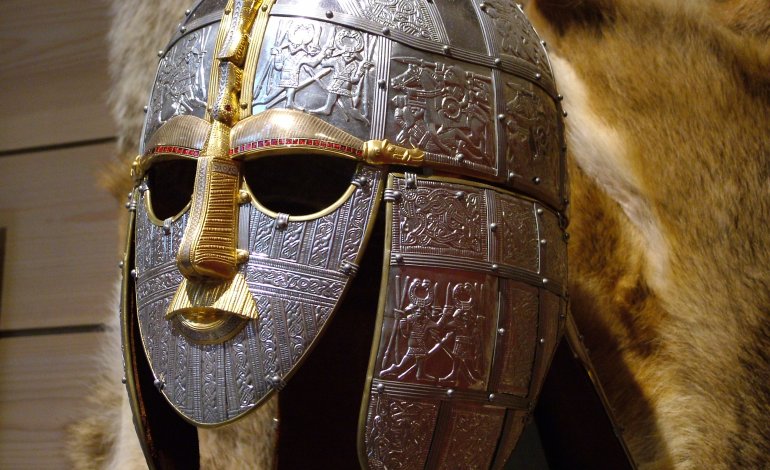It is generally thought most likely that Rædwald, the ruler of the East Angles, is the person buried in the ship. The site has been vital in understanding the Anglo-Saxon Kingdom of East Anglia and the whole early Anglo-Saxon period. The site is one of the most magnificent archaeological finds in England for its size and completeness.
The burial can only be dated on the basis of the coins that were found there. There was a purse among the burial goods, which contained 37 gold coins, 3 coin-shaped blanks, and 2 small gold ingots. It also shows that the world of great halls, glittering treasures and formidable warriors described in Anglo-Saxon poetry was not a myth.
The Sutton Hoo helmet.
Archaeologists discovered this helmet lying in the tomb. It was an amazing, rare find. It was also very unusual because it had a face-mask. Looking at the nose, eyebrows and holes for the warrior's eyes, it can be seen a dragon with outstretched wings, made up by the two bushy eyebrows, nose and mustache. |
| The Sutton Hoo helmet. |
 |
| Its reconstruction. |
When found, the magnificent helmet was in hundreds of pieces. The burial chamber had collapsed and reduced the helmet to a pile of fragments. Pieces of rusted iron were mixed up with pieces of tinned bronze, all so corroded as to be barely recognizable. By precisely locating the remaining fragments and assembling them as if in a three-dimensional jigsaw puzzle, conservators have reconstructed the helmet. A complete replica made by the Royal Armories shows how the original would have looked.
Purse lid from the Sutton Hoo ship burial.
The lid was made to cover a leather pouch containing gold coins. It hung by three hinged straps from the waist belt, and was fastened by a gold buckle. The lid had totally decayed but was probably made of whalebone—a precious material in early Anglo-Saxon England.
 |
| The purse lid. |
The plaques include twinned images of a bird-of-prey swooping on a duck-like bird (above), and a man standing heroically between two beasts. These images must have had deep significance for the Anglo-Saxons, but it is impossible for us to interpret them.

0 comments:
Post a Comment